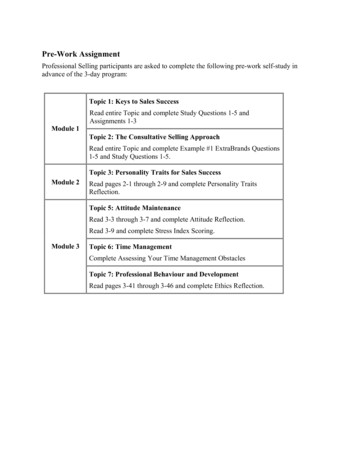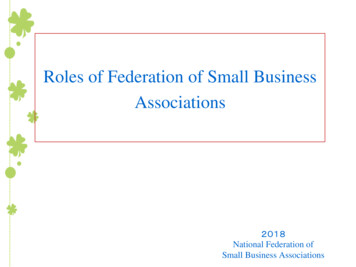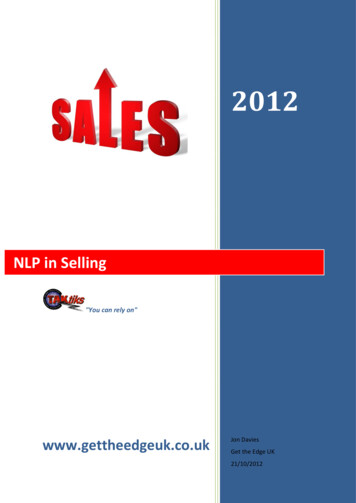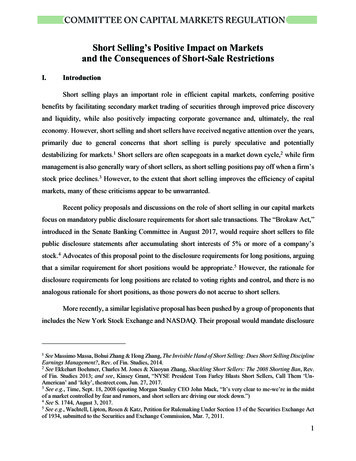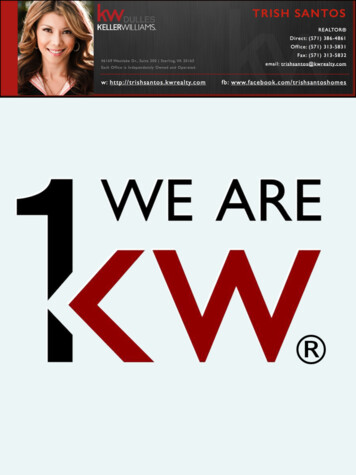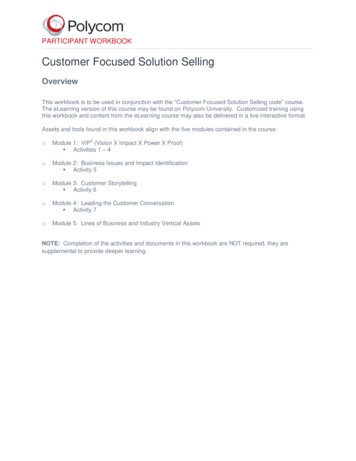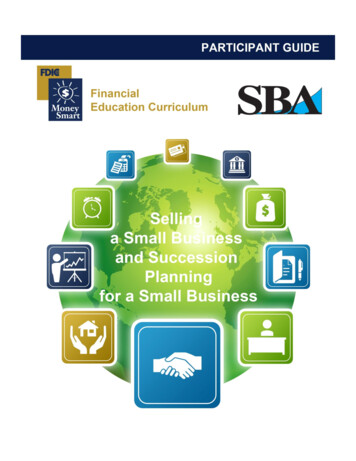
Transcription
Selling a Small Business and Succession Planning for a Small BusinessParticipant GuideTable of ContentsWelcome . 3What Do You Know? Selling a Small Business and Succession Planning . 4Pre-Test . 5Determining If a Business Should Be Sold. 6Discussion Point #1 Reason for Selling the Business. 6Selling a Business . 6Discussion Point #2 Challenges of Selling the Business . 9Closing a Business . 9Planning Succession . 11Discussion Point #3 Benefits of Selecting a Successor. 12Planning Retirement . 12Top Three Key Points to Remember . 14For Further Information . 15Post-Test. 16Evaluation Form . 17DISCLAIMERThese training materials are intended as general guidance only and may or may not apply to a particular situationbased on the circumstances. The materials do not create any legal rights or impose any legally binding requirementsor obligations on the Federal Deposit Insurance Corporation (FDIC) and U.S. Small Business Administration (SBA).The FDIC and SBA make no claims or guarantees regarding the accuracy or timeliness of this information andmaterial.The content of this training material is not designed or intended to provide authoritative financial, accounting,investment, legal or other professional advice which may be reasonably relied on by its readers. If expert assistancein any of these areas is required, the services of a qualified professional should be sought.Reference to any specific commercial product, process, or service by trade name, trademark, manufacture, orotherwise does not constitute an endorsement, a recommendation, or a preference by the FDIC and SBA or theUnited States government.Small Business Financial Education CurriculumPage 2 of 17
Selling a Small Business and Succession Planning for a Small BusinessParticipant GuideWelcomeWelcome to the Selling a Small Business and Succession Planning for a Small Business module. By taking this training,you are taking an important step to building a better business. This guide accompanies the Selling a Small Business andSuccession Planning for a Small Business PowerPoint Presentation.ObjectivesAfter completing this module, you will be able to: Explain how to change the ownership of a business through selling, closing, or handing the businessto successors. Explain how to establish an exit strategy for retirement which includes a succession plan, transferring ownershipof the business, and paying taxes.Small Business Financial Education CurriculumPage 3 of 17
Selling a Small Business and Succession Planning for a Small BusinessParticipant GuideWhat Do You Know?Selling a Small Business and Succession PlanningInstructor: Date:This form will allow you and your instructors to see what you know about selling a small business and successionplanning, both before and after the training. Please read each statement below. Circle the number that shows how muchyou agree with each statement.DisagreeAgreeStrongly AgreeStrongly DisagreeDisagreeAgreeStrongly AgreeAfter TrainingStrongly DisagreeBefore Training1. I can explain how to change the ownership ofa business through selling, closing, or handingthe business to successors.123412342. I can explain how to establish the right exitstrategy for retirement which includes asuccession plan, transferring ownership of thebusiness, and paying taxes.12341234Small Business Financial Education CurriculumPage 4 of 17
Selling a Small Business and Succession Planning for a Small BusinessParticipant GuidePre-TestTest your knowledge of selling a small business and succession planning before goingthrough the course.1. Which of the following are reasons to sell your business? Select all that apply.a. New job offerb. Profits are more than needsc. Market or industry changesd. Someone offers to buye. Ready to retire2. Most business valuation methods are a combination of two factors: .a. Revenue stream and assetsb. Customer base and net worthc. Gross profit and assetsd. Revenue stream and net worth3. When selling your business it is important to know both the buyer’s financial ability and the buyer’smanagement skills.a. Trueb. False4. Succession planning deals with the process of .a. Determining a plan for your business over the next five yearsb. Identifying buyers for your businessc. Passing control of your business to othersd. Selling your business to family members5. Small business retirement plans are not recognized by the Internal Revenue Service (IRS).a. Trueb. FalseSmall Business Financial Education CurriculumPage 5 of 17
Selling a Small Business and Succession Planning for a Small BusinessParticipant GuideDetermining If a Business Should Be SoldWhile many businesses run for years, even over several generations, businesses open and close all the time. Here are afew reasons why you may want to sell or close your business.Business or professional reasons include: Job offer from another company Purchase offer for your business or your business assets Dissatisfaction with sales and profits Changes in the market or industryPersonal reasons include: Retirement Burnout with self-employmentHealth concerns or family needs Desire to go in a new directionDiscussion Point #1 Reason for Selling the BusinessThe purpose of this question is to discuss your reasons for selling the business with the class participants.What is the main reason for selling your business?Selling a BusinessIf you decide to sell your business, here are factors to weigh.Determine If Business Is SaleableBefore starting, you need to determine if you have a saleable business. Here are somequestions to consider when determining if you have a saleable business.Do you have a history of strong profits?A financially strong business has a lot to offer a new owner. If your business is strugglingfinancially, the business will not be as attractive to buyers. Sometimes a business does notSmall Business Financial Education CurriculumPage 6 of 17
Selling a Small Business and Succession Planning for a Small BusinessParticipant Guideeven have a market value beyond the assets of the business.Is the business in an attractive industry?Some types of businesses have more appeal than others.Is the business in a location convenient to potential buyers?Location is important to many businesses. Some businesses can be easily moved, others cannot.Are your assets in good shape?Having assets in good condition, with significant market value and remaining useful life, adds to your business’ value.Do you have quality inventory and good supplier relationships?A prospective buyer wants to see quality (e.g. fresh) inventory and solid relationships with suppliers.Do you have a solid customer base?A healthy list of returning customers makes your business more valuable and attractive.Can you transfer your business to another person?Some businesses are dependent on a particular person’s talents and cannot be transferred to another person.Do you have a healthy balance sheet?A combination of good retained earnings and net worth, low debt, and collectable accounts receivable make for anattractive business that is worth purchasing.Determine Your PriceThe value of your business can be determined by many business valuationmethods. Most valuations are a combination of two factors: Assets, such as cash, receivables, inventory, equipment, andreal estate Revenue stream, that is, net profit over timeAssets are usually priced using market valuation. Valuing revenue streamis more complicated, involving return on investment, comparisons toalternative investments, and growth potential.Many owners get help from accountants, attorneys, and industry specialists when determining the value of theirbusinesses.Prepare for SaleWhen preparing for the sale, here are some items to consider: Resolve outstanding issues such as unpaid accounts receivable, debt, lawsuits, and environmental hazards.Demonstrate that accounts receivable can be collected.Small Business Financial Education CurriculumPage 7 of 17
Selling a Small Business and Succession Planning for a Small Business Prepare historical and projected financial statements. Provide a convincing business plan for the future.Secure beneficial relationships with suppliers and customers. Get the premises in good shape. Sell old inventory.Participant GuideIn addition, you must determine exactly what equipment is included in the sales price and make sure all this business andoffice equipment is in good order. Finally, you should provide a clear picture of how you will be compensated as theowner.Look for Prospective BuyersProspective buyers may include: Employees with enough management experience and skill to take over the business Long-standing customers who might have a passion for your product or serviceBusiness owners whose businesses would be enhanced by your product or service Competitors who might see a benefit in absorbing your businessYou will want to advertise online, through trade associations, and via email to informpotential buyers that your business is for sale.Negotiate the DealNegotiating and structuring a business sale is a complex process. Many business owners engage the expertise of attorneysand accountants. Here are some of the issues to consider.Buyer qualificationJust like buying a home, buyers need to demonstrate the financial ability to purchase abusiness. Demonstrated financial ability includes having sufficient cash and the creditworthiness for borrowing part of the purchase price. A prospective buyer should alsodemonstrate the management skills to run the business.Payment in lump sum or installmentsBuyers can provide the entire price, through a combination of cash and loans from banks, or pay the business seller ininstallments.Non-compete agreementOften business sellers are required to sign an agreement to not start a competing business for a few years.Management assistanceThe new owner of a business may benefit from the previous owner’s expertise. The seller of a business often will serve asa paid consultant or manager for a few months to help the new owners learn how the business operates.Small Business Financial Education CurriculumPage 8 of 17
Selling a Small Business and Succession Planning for a Small BusinessParticipant GuideSales agreement preparationA sales agreement covers many elements of the sale including sale price, buyer deposit, promissory note, security, sellerand buyer’s representations, contingencies, dispute resolution, and more.Down paymentIf a purchase is to be paid in installments, the buyer and seller must agree on a down payment.CollateralIf the purchase requires a loan, all parties must agree on collateral. Often the business itself is collateral. However, if theseller does not want the business back in the case of a default, the parties can negotiate a different form of collateral.As you can see, many factors are involved in the sale of a business. You should work with an experienced attorney and anaccountant to help structure the deal and prepare all the documentation.Discussion Point #2 Challenges of Selling the BusinessThe purpose of this next question is to discuss some of your concerns about selling the business with other participants.What are some of the challenges of selling your business?Closing a BusinessHere are a few reasons why it might make more sense to close a business rather than sell it: The businesses might be too small, with insufficient assets and profitability, to interest a buyer. Businesses in decline are not promising investments. Businesses that are specialized, located in remote areas, or have other unique characteristics may be difficult tosell. Businesses with significant assets, but not sales, might be better off selling the assets and closing.Here are some steps to take when closing your business.Follow Instructions in Your Founding DocumentsIf you're a sole proprietor, you don't need to worry about closing according to the requirements of business organizationaldocuments. If your business is a general partnership that doesn't have a written partnership agreement, then you need toSmall Business Financial Education CurriculumPage 9 of 17
Selling a Small Business and Succession Planning for a Small BusinessParticipant Guidegive notice to your partner of your express desire to withdraw from the partnership. On the other hand, if your business isa partnership with a written partnership agreement, a limited liability company (LLC), or a corporation, you will need tofollow the rules of dissolution contained in the partnership agreement, articles of incorporation, or applicable state laws.File Dissolution Documents with the StateAll limited and general partnerships that filed with a state at the inception of the partnership must file dissolution paperswith the state. Once you have voted to dissolve an LLC or corporation, you file paperwork with the state, certifying thedecision to terminate the business. Filing a certificate of dissolution (also known as articles of dissolution) is a processthat varies from state to state.Sell Business AssetsIf you have business assets, equipment, inventory, and real estate, you will likely want to sell your assets before closingthe business.Cancel Permits, Licenses, and Lease AgreementsReview all the registrations, licenses, and permits you obtained to open and run your business. Contact licensing andpermitting agencies and follow their cancelation processes. If you are leasing office space or equipment, you will need toterminate your leases—review your lease agreement for the details, including what penalties you may incur.Comply with Tax LawsWhen you end a business, the company is still liable for taxes in the prior and the current year. This means that you mustcontinue making deductions from paychecks and continue payroll reporting obligations. You should continue to file yourquarterly or annual taxes, and your capital gains and liquidation forms. You will also be responsible for all final tax formsthat need to be filed, including forms for income tax, sales tax (that has been collected), and payroll taxes.Resolve Outstanding Issues with Customers, Creditors, and SuppliersPay all of your debts, collect balances due from customers (receivables), and close all of your accounts.Maintain RecordsAlthough you’ve closed the doors, continue to maintain and retain business records. You will need to file income taxes,answer inquiries, and respond to agencies seeking information. You could still be audited and may need to answerquestions from those with whom you have done business.Get HelpSeek help from your accountant and attorney to review the closing process.Small Business Financial Education CurriculumPage 10 of 17
Selling a Small Business and Succession Planning for a Small BusinessParticipant GuidePlanning SuccessionSuccession planning involves creating a plan for someone to either ownor run your business after you retire, become disabled, or die. In simpleterms, succession planning is the process of passing control of thebusiness to others. Here are some steps to take for succession planning.Find SuccessorIf you are passing the business to a family member, you may considertransferring ownership through your estate planning process. Often,however, new management comes from your pool of existing employees. If you have a larger business (such as an LLC ora corporation), succession planning involves preparing people for management and leadership roles in order to replaceyou or other managers when the time arises.Finding your replacement is difficult so plan ahead, it is best to start early. Leaders are not always easy to find and it takestime to mentor someone into a management role. You will need to identify potential successors in your family or amongemployees. You can hire from outside the company, but it’s helpful to groom someone already in your business, over aperiod of time, so the transition to new leadership will be smooth.Train SuccessorOnce you have successors identified, deliberately create a training plan to ensure thateveryone involved has time to learn the skills, gather the information, and practice theleadership roles critical to the future success of the business.Whether you are transferring a business to a family member or you are promotingemployees into leadership roles, you need to plan ahead. A succession plan takes intoconsideration the development of future leaders’ skills and abilities. The plan shoulddeliver a return on your business’s training investment by providing for yoursuccessors’ advancement while simultaneously ensuring your successors don’t leave your business. Even if someoneleaves, a current employee should be ready to step into the vacated role. As the need arises, with good successionplanning, employees or family members are ready for new leadership roles.Ease Tax ExposureTax exposure arises when one generation gives way to the next generation in a closely-held family business. In this case,succession planning and estate planning become intertwined by the family. Multiple types of taxes must be consideredwhen planning this type of succession, including: Income taxGift tax Generation-skipping taxEstate taxSmall Business Financial Education CurriculumPage 11 of 17
Selling a Small Business and Succession Planning for a Small BusinessParticipant GuideStart family succession planning sooner, rather than later, because starting sooner will give you more flexibility with yourplanning. Consult an attorney and an accountant about putting the proper estate documents in place, especially forsuccession planning in a family business.Discussion Point #3 Benefits of Selecting a SuccessorThe purpose of this discussion is to provide reasons for selecting a successor.What is the most important reason for selecting a successor?Planning RetirementSmall business retirement plans are a means to help employers and employees save toward retirement.Retirement Plan BenefitsA retirement plan has many benefits. Primarily, a retirement plan helps you and your employees to save and invest towardfinancial security in retirement. You and your employees get significant tax advantages and other incentives: Employer contributions are tax-deductible. Assets in the plan grow tax-free.Flexible plan options are available.A retirement plan can attract and retain employees, reducing new employee training costs.Employee benefits include: Contributions to the plan reduce current taxable income. Contributions and investment gains are not taxed until the contributions and gains are distributed.Contributions can be easy to make through payroll deductions. Small regular contributions can grow to significant retirement savings over time as a result of compounding. Theearlier in life an employee starts to save, the more they will benefit from compound growth.Retirement assets can be transferred to a new plan if the employee leaves the company. Retirement PlansThe Internal Revenue Service (IRS) recognizes small business retirement plans as a means to help employers andemployees save toward retirement. People tend to think of an IRA as something that individuals establish on their own,but an employer can help its employees set up and fund their IRAs. With an IRA, the amount that an individual receives atSmall Business Financial Education CurriculumPage 12 of 17
Selling a Small Business and Succession Planning for a Small BusinessParticipant Guideretirement depends on the funding of the IRA and the earnings (or losses) on those funds. The plans are relatively easy toestablish--your financial institution handles most of the details. There are three key types of IRA-based options: Simplified Employee Pension Plan (SEP): Simplified Employee Pension (SEP) plans are available for anysize business. Only the employer contributes to the retirement plan—the employer can contribute up to 25percent of each employee’s pay. The contributions are made to a traditional IRA. Contributions to a SEP aretax deductible and your business pays no taxes on the earnings on the investments. You may be eligible for atax credit of up to 500 per year for each of the first 3 years for the cost of starting the plan. SIMPLE (Savings Incentive Match Plan for Employees) Individual Retirement Account Plan: ASIMPLE IRA plan allows a business that has 100 or fewer employees to help employees save for retirement.Employees can contribute to the IRA, on a tax-deferred basis, through payroll deductions. As the businessowner, you can choose either to match the employee’s contributions or to contribute a fixed percentage of alleligible employees’ pay. You may be eligible for a tax credit of up to 500 per year for each of the first 3years for the cost of starting a SIMPLE IRA plan. Payroll Deduction IRAs: Even if an employer does not want to adopt a retirement plan, it can allow itsemployees to contribute to an IRA through payroll deductions. The employer sets up the payroll deductionIRA program with a bank, insurance company or other financial institution, and then the employees choosewhether and how much they want deducted from their paychecks and deposited into the IRA. Employees mayalso have a choice of investments depending on the IRA provider. The employee makes all of thecontributions. There are no employer contributions.Under Federal law, individuals saving in a traditional IRA may be able to receive some tax advantages on the money theysave, up to a certain amount, and the investments can grow tax-deferred. If the individual selects a Roth IRA, theemployee’s contributions are after-tax and the investments grow tax-free. A Roth IRA, like the Traditional IRA, providesfor retirement withdrawals after the age of 59 ½ (within the guidelines). However, the tax benefit is opposite from theTraditional IRA. Whereas the Traditional IRA allows for a tax deduction in the year for which the deposit was made, theRoth does not. The benefit of the Roth IRA is that no tax is levied on the interest income after you retire.Another retirement plan option is defined contribution plans, such as a 401(k) plan or a profit-sharing plan. Theseemployer-established plans also do not promise a specific amount of benefit at retirement. Instead, employees or theiremployer (or both) contribute to employees’ individual accounts under the plan, sometimes at a set rate (such as 5 percentof salary annually). At retirement, an employee receives the accumulated contributions plus earnings (or minus losses) onthe invested contributions. Defined benefit plans, on the other hand, promise a specified benefit at retirement, forexample, 1,000 a month at retirement.A common defined contribution plan option is the 401(k) Plan. A 401(k) plan allows participants to decide how much tocontribute to their accounts, and employers are entitled to a tax deduction for any contributions they make to employees’accounts. The money contributed may grow through investments in stocks, bonds, mutual funds, money market funds,savings accounts, and other investment vehicles. Contributions and earnings generally are not taxed by the FederalGovernment or by most State governments until they are distributed. 401(k) plans can vary significantly in theircomplexity. However, many financial institutions and other organizations offer prototype 401(k) plans, which can greatlySmall Business Financial Education CurriculumPage 13 of 17
Selling a Small Business and Succession Planning for a Small BusinessParticipant Guidelessen the administrative burden on individual employers or self-employed individuals of establishing and maintainingthese plans. Banks that provide 401(k) retirement savings products will generally assist you in setting them up with youremployees and even provide education for your employees on important features of the plan.Starting a Retirement PlanStarting a retirement savings plan can be easier than most business owners think. By starting a retirement savings plan,you will help your employees save for the future. What’s more, retirement programs can provide tax advantages to bothemployers and employees. You can establish a plan even if you are self-employed.Review retirement plans with a tax advisor. Then, as necessary,contact a plan administrator to open your small businessretirement plan. Ask your bank, accountant, or businessattorney for plan administrator recommendations.If you have employees, notify them about the plan, includingthe plan’s provisions and eligibility guidelines. Eligibilityguidelines should include an enrollment period whenadministrators are available to answer employee questions.When the plan is in place, integrate contributions to the planinto your regular business and financial management practices.Retirement savings should be built into your overall businessplan to ensure there are sufficient profits to provide forretirement savings.Top Three Key Points to Remember1. Transitions that include selling a business, closing a business, and retiring are all part of the life cycle of a business,and you should prepare for them.2. If you are just starting your business, you may not need to focus on all of these transitions right away.3. However, you should have a strategy to save for your retirement and work toward it with regular contributions to yourretirement account. Small business retirement plans are a means to help employers and employees save towardretirement.Small Business Financial Education CurriculumPage 14 of 17
Selling a Small Business and Succession Planning for a Small BusinessParticipant GuideFor Further InformationFederal Deposit Insurance Corporation (FDIC)http://www.fdic.govThe Federal Deposit Insurance Corporation (FDIC) preserves and promotes public confidence in the U.S. financialsystem by insuring deposits in banks and thrift institutions for at least 250,000; by identifying, monitoring, andaddressing risks to the deposit insurance funds; and by limiting the effect on the economy and the financial systemwhen a bank or thrift institution fails.The FDIC encourages bank lending to creditworthy small businesses. The FDIC also encourages small businessesthat may have an inquiry or concern about the availability of credit to contact the FDIC Small Business Hotline at1-855-FDIC-BIZ or http://www.fdic.gov/smallbusiness. Another FDIC website,http://www.fdic.gov/buying/goods, provides resources to assist small businesses that may want to do business withthe FDIC.U.S. Small Business Administration (SBA)http://www.sba.govSBA Answer Desk: 1-800-827-5722The U.S. Small Business Administration (SBA) web site provides resources, answers to frequently askedquestions, and other significant information for small business owners.U.S. Financial Literacy and Education Commissionhttp://www.mymoney.gov1-888-My-Money (696-6639)MyMoney.gov is the federal government's one-stop web site that provides financial education resources from morethan 20 federal agencies.Small Business Financial Education CurriculumPage 15 of 17
Selling a Small Business and Succession Planning for a Small BusinessParticipant GuidePost-TestNow that you’ve gone through this module, see what you’ve learned.1. Which of the following are reasons to sell your business? Select all that apply.a. New job offerb. Profits are more than needsc. Market or industry changesd. Someone offers to buye. Ready to retire2. Most business valuation methods are a combination of two factors: .a. Revenue stream and assetsb. Customer base and net worthc. Gross profit and assetsd. Revenue stream and net worth3. When selling your business it is important to know both the buyer’s financial ability and the buyer’smanagement skills.a. Trueb. False4. Succession planning deals with the process of .a. Determining a plan for your business over the next five yearsb. Identifying buyer
Selling a Small Business and Succession Planning for a Small Business Participant Guide Small Business Financial Education Curriculum Page 10 of 17 give notice to your partner of your express desire to withdraw from
